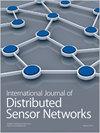一种适用于水下无线传感器网络的深度控制节能路由协议
IF 2.5
4区 计算机科学
Q3 COMPUTER SCIENCE, INFORMATION SYSTEMS
International Journal of Distributed Sensor Networks
Pub Date : 2022-09-01
DOI:10.1177/15501329221117118
引用次数: 41
摘要
水下无线传感器网络引起了研究者的广泛关注。在水下无线传感器网络中,许多传感器节点分布在海洋的不同深度。由于其复杂性,更新他们的位置或添加新设备非常具有挑战性。由于水下无线传感器网络终端设备的能量存储受到限制,并且水下设备维修或充电的复杂性,这对提高水下无线传感网络的能量性能具有重要意义。功耗的不平衡可能导致性能差和网络寿命有限。为了克服这些问题,我们提出了一种深度控制的能量平衡路由协议,该协议将能够调整较低能量节点的深度,并能够将较低能量的节点与较高能量的节点交换,以确保一致的能量利用。所提出的节能路由协议基于增强的遗传算法和数据融合技术。在所提出的节能路由协议中,通过添加编码策略、交叉过程和改进的变异操作来增强现有的遗传算法,以帮助确定节点。所提出的模型还利用了一种增强的反向传播神经网络进行数据融合操作,该网络基于多跳系统,还采用了高度优化的动量技术,这有助于只选择最佳能量节点,避免重复选择,从而有助于提高整体能量,进一步减少数据传输量。在所提出的节能路由协议中,使用增强型簇头节点来选择能够分析每个参与节点的剩余能量和方向的策略。在仿真中,与现有的基于深度的路由和基于深度的节能路由方法相比,该模型实现了86.7%的分组传递率、12.6%的能耗和10.5%的分组丢弃率。本文章由计算机程序翻译,如有差异,请以英文原文为准。
A depth-controlled and energy-efficient routing protocol for underwater wireless sensor networks
Underwater wireless sensor network attracted massive attention from researchers. In underwater wireless sensor network, many sensor nodes are distributed at different depths in the sea. Due to its complex nature, updating their location or adding new devices is pretty challenging. Due to the constraints on energy storage of underwater wireless sensor network end devices and the complexity of repairing or recharging the device underwater, this is highly significant to strengthen the energy performance of underwater wireless sensor network. An imbalance in power consumption can cause poor performance and a limited network lifetime. To overcome these issues, we propose a depth controlled with energy-balanced routing protocol, which will be able to adjust the depth of lower energy nodes and be able to swap the lower energy nodes with higher energy nodes to ensure consistent energy utilization. The proposed energy-efficient routing protocol is based on an enhanced genetic algorithm and data fusion technique. In the proposed energy-efficient routing protocol, an existing genetic algorithm is enhanced by adding an encoding strategy, a crossover procedure, and an improved mutation operation that helps determine the nodes. The proposed model also utilized an enhanced back propagation neural network for data fusion operation, which is based on multi-hop system and also operates a highly optimized momentum technique, which helps to choose only optimum energy nodes and avoid duplicate selections that help to improve the overall energy and further reduce the quantity of data transmission. In the proposed energy-efficient routing protocol, an enhanced cluster head node is used to select a strategy that can analyze the remaining energy and directions of each participating node. In the simulation, the proposed model achieves 86.7% packet delivery ratio, 12.6% energy consumption, and 10.5% packet drop ratio over existing depth-based routing and energy-efficient depth-based routing methods for underwater wireless sensor network.
求助全文
通过发布文献求助,成功后即可免费获取论文全文。
去求助
来源期刊
CiteScore
6.50
自引率
4.30%
发文量
94
审稿时长
3.6 months
期刊介绍:
International Journal of Distributed Sensor Networks (IJDSN) is a JCR ranked, peer-reviewed, open access journal that focuses on applied research and applications of sensor networks. The goal of this journal is to provide a forum for the publication of important research contributions in developing high performance computing solutions to problems arising from the complexities of these sensor network systems. Articles highlight advances in uses of sensor network systems for solving computational tasks in manufacturing, engineering and environmental systems.

 求助内容:
求助内容: 应助结果提醒方式:
应助结果提醒方式:


